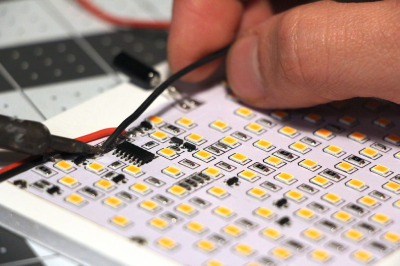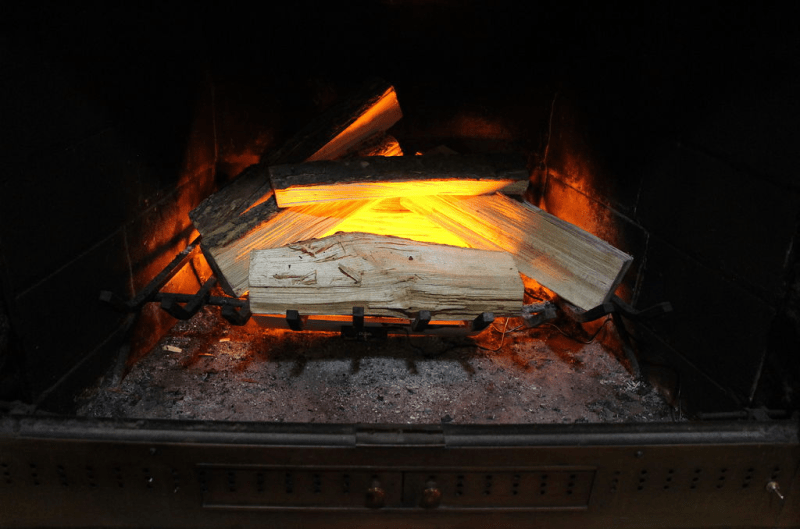Ask anyone who’s ever tuned into Fireplace TV on a cold winter’s night — even though you can’t feel the heat or roast a marshmallow with it, fake fire is almost as soothing as the real thing. And if you have kids or pets, it’s a whole lot safer. But why go to the expense of buying a lighted insert when you could just make your own?
You don’t even need to get fancy with a microcontroller and RGB LEDs, either — just do what [Ham-made] did and dismantle some LED flame bulbs. They already have everything you need, and the flex PCB makes them easy to work with.
 [Ham-made] adhered three bulbs’ worth to a piece of foam board with double-stick tape, soldered all the leads together, and wired in a toggle switch and a 2xAA battery pack. The bulbs each had a tilt switch so that the “flames” flow upward regardless of orientation, but [Ham-made] removed those to avoid flickering connectivity and fights with the toggle switch.
[Ham-made] adhered three bulbs’ worth to a piece of foam board with double-stick tape, soldered all the leads together, and wired in a toggle switch and a 2xAA battery pack. The bulbs each had a tilt switch so that the “flames” flow upward regardless of orientation, but [Ham-made] removed those to avoid flickering connectivity and fights with the toggle switch.
Once it was all wired up, [Ham-made] hot-glued some magnets to the foam board and attached it to the underside of the grate to keep it safe from the logs and the ash pit, while still allowing the glow to emanate from the right spot for realism. The only thing missing are the crackles and pops, and [Ham-made] is burning to hear your implementation ideas.
[Ham-made] wasn’t using his fireplace in the traditional way because the house is smallish and centrally heated. But if you rely on yours to keep you warm and cozy, why not make it voice-activated?
















You may want to check out [Adam Savage]’s One Day Build: v=JMv0PlMKkbs which uses an off-the-shelf fake fire bulb with a neat housing. On top of that is the surprisingly easy conversion of the mains powered bulb to 3v AA battery pack. Gotta start looking into my old parts bin of broken LED bulbs to see which ones are salvageable and convertible for battery pack use.
I have experience with Opti-Myst effect in Fireplace it’s really nice and looks like real fire.
https://www.google.com/search?hl=en&gbv=1&tbm=vid&q=Opti-myst+fire+&oq=&aqs=
>adhered three bulbs’ worth to a piece of foam board with double-stick tape
Foam board is an insulator. LED PCB serves as heat spreader + heatsink. Congratulation, you have effectively remove 1/2 of the surface area for the heat dissipation for the LED bulb.
I think this is more than canceled out by removal of the plastic outer shell. Although it would also be an option, to use Al sheet metal as a carrier of the flex PCBs.
I will agree that the foam was not the best choice, but given the fact that the original design had the PCB wrapped in a circle and inside a sealed enclosure, I would bet his setup in “open air” will be at least equal in dissipation. It is a valid point to at least be taken into consideration, though.
They make another type of bulb, which has a very very long loose filament. When the current goes through the filament the heat causes the filament to jump and flicker around. This leads to a flickering flame look
I put one of these bulbs in my fireplace a while ago. I live in South FL, so the fireplace was useless before this. I was thinking of painting some random patterns of reflective paint to make the logs look like they were glowing
At Christmas time here it is 30-40deg c so the fireplace is not in use. We have taken to pooping some tinsel and a bunch of LED Christmas lights in. Gives a nice effect behind the Christmas tree.
That’s an amusing typo. The smell must be terrible :-)
Or, a cue for a joke about what kind of animal poops tinsel? A unicorn?